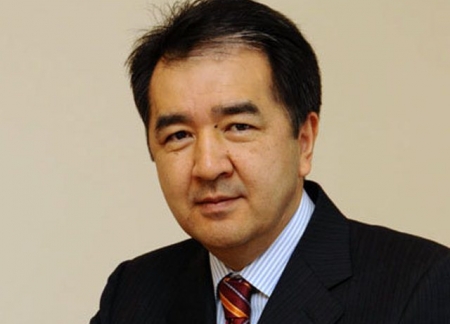Kazakhstan to study oil recovery efficiency

By Aynur Karimova
Kazakhstan will hold a detailed analytical study on how to improve the efficiency of oil recovery on fields.
The news was announced by Bakytjan Sagintayev, the first deputy
prime minister on June 1 at parliamentary hearings on “Problems and
prospects of development of Kazakh oil and gas industry."
He noted incentives for subsoil users will be identified on the
basis of this study.
“An analytical study on the plans and forecasts on implementation
of projects to increase the production efficiency on the oil fields
will be carried out before late 2015,” he said. “To improve the
efficiency of oil recovery the government plans to take concrete
measures to stimulate subsoil users.”
Currently, over half of the country's deposits have reached a peak
production and are mature, that is, they have a low level of oil
extraction.
President Nursultan Nazarbayev has ordered the government to
implement technological policy which envisages increasing oil
recovery coefficient by at least 5-7 percent (from the current
level of 30 percent). This figure reaches 50 percent in the
world.
Sagintayev went on adding that the government has taken measures for the reconstruction and modernization of an existing three refineries to reduce import dependence. Also, the government actively works on the construction of a fourth refinery, the technical and economic parameters of which are being defined now.
Pipeline construction will continue
Sagintayev also said the Kazakh government will invest 656 billion tenge ($3.528 billion) in the construction of gas pipelines. The main goal is to implement the General Scheme of gas supply in the country.
According to the General Plan, the level of gasification of the
population will reach 56 percent by 2030, which currently is 42
percent. Also, the number of gasified settlements will be increased
from 1,150 to 1,600, while the volume of gas consumption will rise
from 12.4 billion cubic meters in 2014 to 18 billion in 2030.
He noted Kazakhstan's gas production has reached 42.3 billion cubic
meters a year. Experts estimate that the natural gas reserves in
the country reached 4 trillion cubic meters.
Tengiz, Kashagan and Karachaganak fields
Touching upon the Tengiz field, Sagintayev said it is planned to
increase oil production at this field to 38 million tons a
year.
"It is planned to increase the oil production by 1.4 times, from 27
million to 38 million tons a year at the Tengiz field,” he
noted.
The official also said rehabilitation works are underway at the
Kashagan field, where commercial oil production will be restored by
the end of 2016.
The government considers the chance of increasing the volume of gas
injection and construction of a new production line on processing
of liquid hydrocarbons as part of the expansion project at the
Karachaganak field, Sagintayev noted.
Commissioning of the project is planned in 2022.
Kazakhstan, one of the five Central Asian countries, is rich with hydrocarbon reserves. The country's production comes mainly from five onshore fields - Tengiz, Karachaganak, Aktobe, Mangistau, and Uzen - and two offshore fields - Kashagan and Kurmangazy, both located in the Caspian Sea.
The recoverable oil reserves of Kashagan field are estimated at 11 billion barrels, whereas total geological raw material reserves stand at 35 billion barrels. Besides, natural gas reserves are estimated at over 1 trillion cubic meters.
The Tengiz oil field is one of the deepest and largest oil fields in the world. Reserves of the deposit are estimated at 750 million to 1.1 billion tons (6-9 billion barrels) of recoverable oil.
Karachaganak is one of the world's largest fields. Its oil reserves amount to 1.2 billion tons, while those of natural gas are 1.35 trillion cubic meters.
Eurasia project in focus
In his remarks Energy Minister Vladimir Shkolnik said a number
of leading oil and gas companies are interested in the
Kazakh-Russian Eurasia project, which envisages the exploration of
hydrocarbon reserves in the Caspian basin.
Shkolnik noted that, according to leading experts' studies, the
depths of the Caspian Basin could contain huge hydrocarbon
reserves, estimated at 60 billion tons of oil.
"So, we launched the Eurasia project, which provides for the
application of innovative technologies and parametric drilling to a
depth of 15 kilometers," he added.
The Eurasia project involves exploration and drilling operations in
the Caspian basin.
The implementation of the project will be carried out in three
phases. The first phase envisages the collection and processing of
materials from previous years. The second phase includes
large-scale researches. The last phase includes the drilling of a
new support-parametric well called Caspian 1, at the depth of
nearly 14-15 kilometers.
It is expected that exploration will be carried out not only in the Caspian Sea, but also in Atyrau, West Kazakhstan and Aktobe regions of Kazakhstan and neighboring Russian regions, in particular Astrakhan, Volgograd, Saratov and Orenburg.
The estimated cost of the three phases of the Eurasia project is about $500 million. The implementation of the project will cover 2015-2020.
--
Aynur Karimova is AzerNews’ staff journalist, follow her on
Twitter: @Aynur_Karimova
Follow us on Twitter @AzerNewsAz
Here we are to serve you with news right now. It does not cost much, but worth your attention.
Choose to support open, independent, quality journalism and subscribe on a monthly basis.
By subscribing to our online newspaper, you can have full digital access to all news, analysis, and much more.
You can also follow AzerNEWS on Twitter @AzerNewsAz or Facebook @AzerNewsNewspaper
Thank you!
